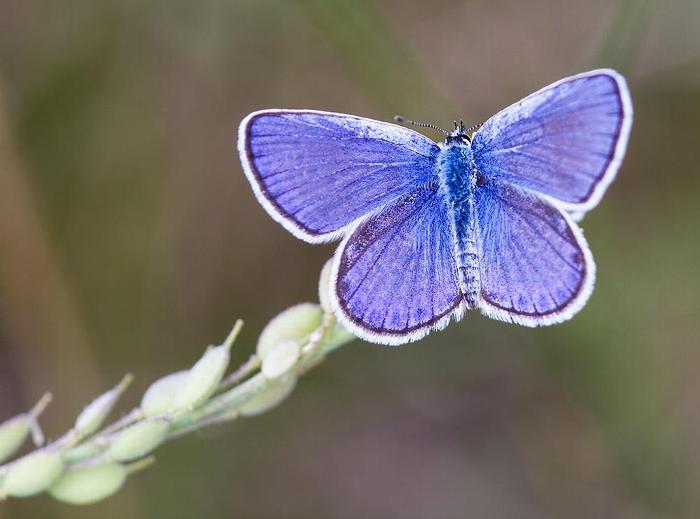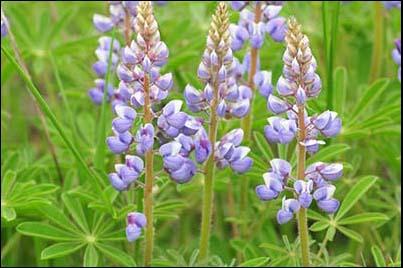Friday, May 12, 2017

Butterflies embody the transcendent journey of nature. Fascinated with their metamorphic abilities, many harbor a love for the butterfly's diverse incarnations. Sadly, there are ongoing threats to the habitats of many of these butterfly species. One such species is the Karner blue butterfly (Lycaeides melissa samuelis), which according to the U.S. Fish and Wildlife Service has declined by 99% over the past 100 years, 90% of which occurred in the past 15 years.
Found near the Great Lakes and the northeast United States, this subspecies of the Melissa blue butterfly have a wingspan of about one inch. Individual adults usually live only five days or so, with females living up to two weeks. They are identified as male and female from telling characteristics. Males have a silvery or dark blue topside with narrow black margins—whereas female wings are gray-brown with a blue topside, featuring orange bands inside a black border. Both males and females sport the same gray underside with beautiful organge crescents along the edge of the wings, with scattered black spots circled with white.

In Michigan, Karner blues have historically lived in the western and southern Lower Peninsula. The amount of available habitat for Karners has reduced, causing a significant population decline. The Karner blue suffered extreme habitat loss and degradation, causing a massive population drop from 1970 to 1980, becoming federally listed as endangered in 1992. It has since been listed as a Michigan threatened species (plants and animals likely to become endangered). The species is currently surviving in at least 10 southern Michigan counties.
Karners prefer to live in oak savannas and pine barrens, and are found inhabiting areas that are partially shady with sandy oil. Previously living in a range from Maine to Minnesota, the Karner blue butterfly now exists only in smaller populations in Michigan, Ohio, Indiana, Wisconsin, New York and Minnesota and is believed to have disappeared permanently in Illinois, Iowa, Pennsylvania, Maine, New Hampshire and Ontario.
The wild blue lupine (Lupinus perennis) is the only food source for the Karner caterpillar larvae, and adults feed on the flowering plant nectar. Yet the habitats do not completely overlap, the Karner population range occupying only the north-most growth extent of the lupine. These factors greatly restrict where the Karner can live, endangering the species. Habitats are also lost when plants like the lupine lose in competition with other vegetation in these habitat ranges, like pine and oak trees.

Other primary causes of Karner blue habitat destruction are land development and a lack of natural disturbance, such as wildfire and grazing by large mammals. Without fire, the kind of open-canopy habitats lupine plants require become overgrown into closed-canopies. These events maintain their habitat by keeping forests from encroaching and adding in their growth of plants like the lupine. Now the Karner blue mostly survives in degraded openings, old fields, and utility and highway rights-of-way.
Researchers continue to search for the best way to manage their population. The U.S. Fish and Wildlife Service have created and implemented a Recover Plan for protecting and restoring the Karner blue. Many butterfly collectors may wish to have a Karner blue for its rarity, but due to their low numbers even collecting a few individuals could harm their survival, and to legally collect one must obtain a permit from the FWS. In some places, the butterfly's habitats are managed and protected. Wisconsin has implemented a statewide Habitat Conservation Plan that permits human activities in areas that support the species and its habitat. Zoos have reintroduced Karner blues by propogating them in new suitable habitats in Ohio, Indiana and New Hampshire in areas where the Karner has previously been extirpated.
At MNA sanctuaries, visitors can observe these beautiful butterflies. MNA is fighting for the conservation of the Karner blue butterfly, restoring critical habitat in several counties. MNA is protecting these "conservation-reliant" species through active restoration and stewardship, using techniques like prescribed fire, to maintain their habitat.
There are many ways people can play a critical role in protecting the future of this species by supporting local conservation efforts. In addition, help protect the Karner blue butterfly by conserving or managing your property for Karner blue and other rare species, contacting local Landowner Incentives Program (LIP) Biologists, learning more about federal programs available to landowners, supporting the use of prescribed fire to maintain prairies and savannas, and limiting or avoiding the use of pesticides near Karner blue butterfly habitats.
Learn more about this unique endangered butterfly at the Michigan Nature Association's third annual Karner Blue Butterfly Family Fun Run & 5K on May 20 at Millennium Park in Grand Rapids. This event will help to raise awareness for endangered species and habitat conservation efforts. Sign up at https://runsignup.com/Race/MI/Walker/KarnerBlueButterflyRun.

Photo: Pamela Ferris
